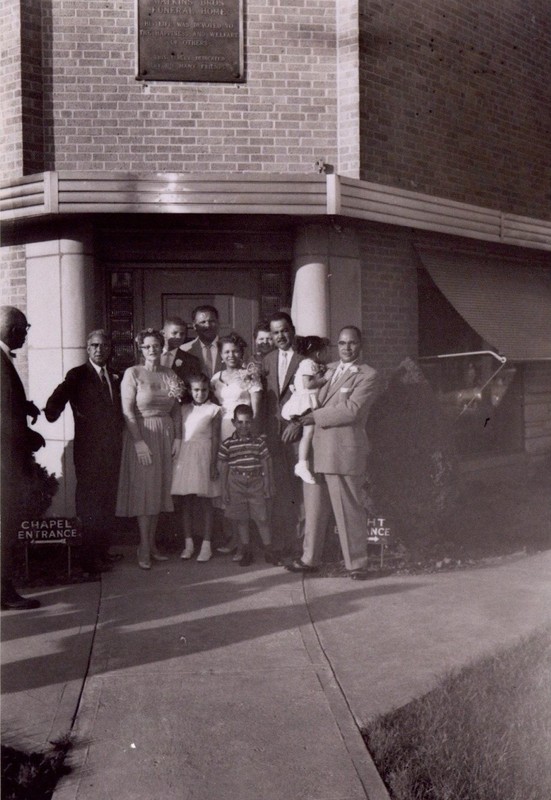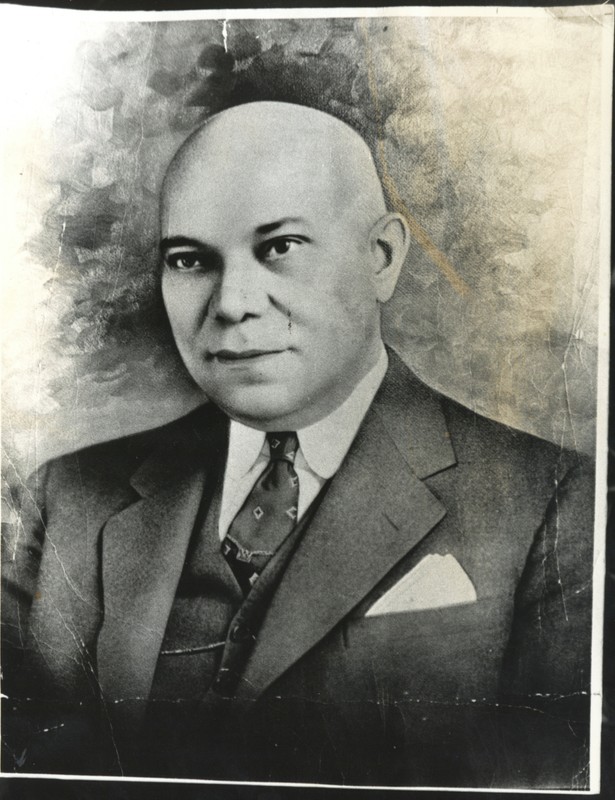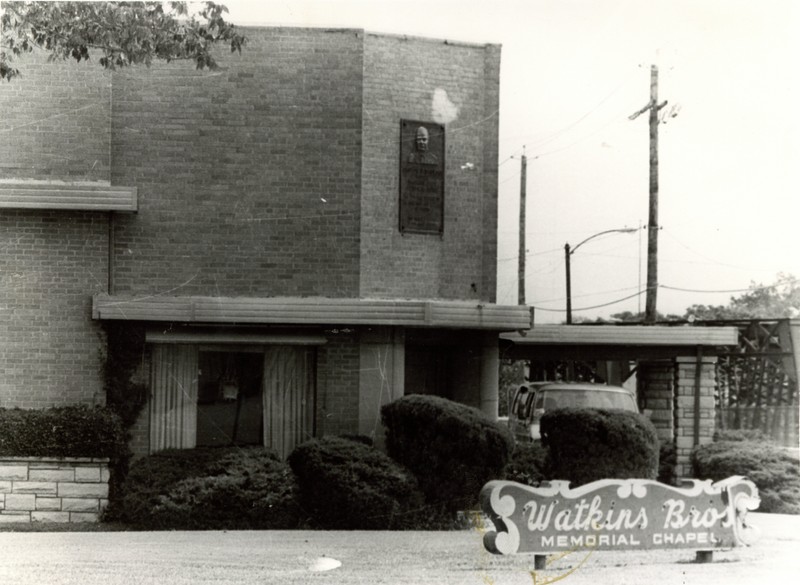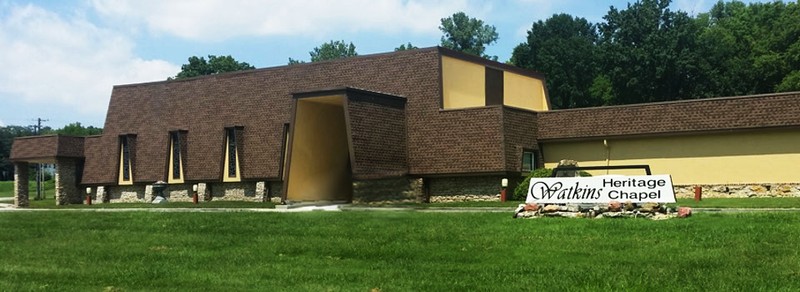Watkins Brothers Funeral Home
Introduction
Text-to-speech Audio
Located here for many years, Watkins Brothers Funeral Home has been a longtime staple of the Black community in Kansas City. Founded by Theron B. Watkins and his brother J.T. in 1908, the funeral home served as the launching point for multiple community figures to begin lifetimes of activism. Founder Theron B. Watkins served on various boards, and was know as a powerful public speaker. In 1922, he ran a highly successful and broadly supported campaign for the office of Eighth Ward Representative, though he was ultimately not elected. His stepson, Bruce R. Watkins was also a highly influential member of his community and one of the most powerful voices behind the foundation and early success of the Black political organization known as Freedom, Inc. Working with notables such as Leon Jordan, Bruce Watkins helped to usher in landmark voter registration numbers and supported numerous successful candidates for municipal, state, and federal offices. The younger Watkins also served two terms on the City Council, two terms as a Circuit Clerk in Jackson County, and mounted a mayoral campaign in 1979. This location was home to Watkins Brothers for many years which now operates out of a new building on Emmanuel Cleaver Boulevard while this building is home to Golden Gate Funeral and Cremation Services.
Images
A picture of Bruce Watkins (second from right) and family standing outside the funeral home at 2841 E. 18th Street, dated sometime from 1953 to 1964.

Bruce Watkins 1978-79 Mayoral Campaign Flyer
![A portrait-style political flyer. Large red and blue text at the top of the page reads "WE CAN WIN [new line] IF YOU REGISTER AND VOTE!" In the center of the page, there is a black and white portrait printed in blue ink. The portrait shows an older African-American man in a dark suit, white shirt, and medium-color tie. He has short hair and a mustache, and is wearing glasses. He is looking at the camera. Below the portrait, a diagonal line of red text reads "Kansas City needs BRUCE". Below the red text, there is a red diagonal stripe with the word "WATKINS" in white text. Below the red stripe, there is a parallel diagonal blue stripe with the word "MAYOR" in white text. Below the blue stripe, in the bottom right corner, there are four small lines of text, one below the other. The first line reads "Paid for by Watkins for Mayor Committee". The second line reads "Ollie Gates, Treasurer". The third line reads "Mail Contributions to P.O. Box 6080, K.C., MO. 64110". The fourth line reads "Volunteer by calling: 361-7771"](https://storage.googleapis.com/clio-images/medium_6438_BW%20Mayoral%20Campaign%20Flyer%2078-79%20COLOR20221118_09531151.jpg)
Portrait of Theron B. Watkins, Date unknown

Picture of Watkins Brothers Funeral Home at 18th and Benton. Date Unknown

The current location of Watkins Heritage Chapel at 4000 Emmanuel Cleaver II Boulevard, Kansas City, MO, 64130. Date Unknown

Backstory and Context
Text-to-speech Audio
Theron B. Watkins was born to John D. and Martha Lyons Watkins on March 24, 1877, near the town of Charlottesville, Indiana. After his father died when he was five, Watkins' mother moved herself and her four children to Carthage, Indiana. After graduating high school in Carthage, Theron Watkins earned a degree from Indiana State University before spending several years working in some capacity for the Pullman Company. He then got a job with Raymond Johnson, a white undertaker, who inspired Theron to go into the funeral business. He graduated from the Cincinnati School of Embalming in 1908 and moved to Kansas City with his brother J.B. in 1909. Several months later, the two opened the Watkins Brothers Funeral Home at 1729 Lydia Avenue. Though J.T. passed away in 1917, the business continued to thrive, putting Theron Watkins in a remarkable spotlight as a successful Black businessman and community member.
Outside of the funeral business, Theron B. Watkins was a highly influential figure in local politics. In 1922, Watkins ran a highly influential campaign to become Representative of Kansas City's Eighth Ward, though he was ultimately not elected. Watkins also helped establish the Paseo YMCA the People's Finance Corporation. Furthermore, he sat on many boards and councils, including the board of directors at Wheatley-Provident Hospital, the Kansas City Housing Authority (where he was the only African-American board member), and the local Selective Service Board during World War II. Theron B. Watkins died at the age of 73 on September 4, 1950.
Bruce R. Watkins was born in Parkville, MO in 1920. Originally Bruce Riley, he changed his name when his mother married Theron B. Watkins. Bruce served in World War II as a navigator and bombardier with the 99th Pursuit Squadron, also known as the Tuskegee Airmen. Upon his return, Watkins followed in his father's footsteps and worked at the funeral home for several years. According to Northeast News, the younger Watkins was inspired by his step-father to live a life of community advancement and activism. He is perhaps most well-known for serving as the Co-Chair of the Freedom, Inc. political organization, which registered unprecedented numbers of African-Americans to vote and propelled many candidates into office, including notables such as Emmanuel Cleaver. Watkins was also the first African-American to successfully run for City Council, being elected to his first term in 1963. Three years later, he became the first Black Jackson County Circuit Court Clerk. In 1975, Watkins served a second term on the City Council, before becoming the first Black mayoral candidate in 1978, though his campaign was not successful. Bruce R. Watkins passed away from lung cancer on September 13, 1980, and has been posthumously honored throughout Kansas City. The Spirit of Freedom Fountain at Cleveland and Brush Creek Boulevard is dedicated to his memory, and both a community center at 3700 Blue Parkway and a section of U.S. 71 Highway bear his name.
The funeral home that bears the family name is still in operation, and the legacy of the Watkins family stretches far beyond the services they provided their customers. Both father and son lived lives of above-and-beyond service to the African-American community of Kansas City and to the Metro area at large.
Sources
Coulter, Charles R.. Taking Up the Black Man’s Burden: Kansas City's African American Communities, 1865-1939. Columbia, MO. University of Missouri Press, 2016.
“Bruce R. Watkins: Kansas City Black History.” KC Black History. Accessed November 17, 2022. https://kcBlackhistory.org/articles/bruce-r-watkins.
Partain, Dorri. “Remember This? Bruce R. Watkins.” Northeast News, February 16, 2022. http://northeastnews.net/pages/remember-this-14/.
“Theron B. Watkins House.” African American Heritage Trail of Kansas City. Accessed November 16, 2022. https://aahtkc.org/theron-b-watkins-house.
Watkins Heritage Chapel | Kansas City MO funeral home and cremation. Accessed November 18, 2022. https://www.watkinsheritage.com/.
William Fambrough, Sr. Negatives Collection, Courtesy of The Black Archives of Mid-America
Courtesy of The Black Archives of Mid-America
Courtesy of The Black Archives of Mid-America
Courtesy of The Black Archives of Mid-America
Watkins Heritage Chapel website
